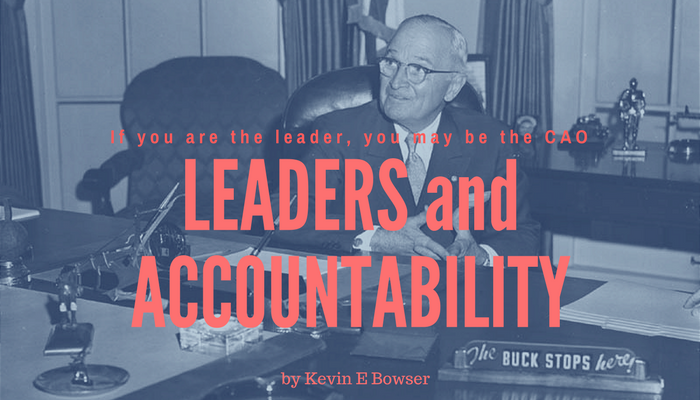What is a “CAO?” That would be a “Chief Accountability Officer.” And you probably won’t find one in the C-suite of your organization. But there probably ought to be one. In fact, accountability is one of the key functions of a leader when the leader has other leaders who report to them from an administrative perspective.
A History Lesson
For those of you who are lovers of history, you will know or remember that President Harry S Truman had a sign on his Oval Office desk that read: “The Buck Stops Here.” It meant that he accepted responsibility and that he was accountable for all the decisions of his administration. He accepted them for his entire administration. President Truman’s stand still exists in a few organizations today but, unfortunately, it is the exception rather than the rule.
More than Personal Accountability
But my point today is not about accepting personal responsibility. The point I want to make today is that if YOU are a leader, you have a responsibility to hold those around you accountable for their actions or inactions. I am fairly sure that President Truman didn’t let his Cabinet and the rest of his administration run wild and then accept the responsibility and any blame for their actions. That would not be good leadership. He realized that he was ultimately accountable. But, I am sure that he worked with his Cabinet Secretaries and the rest of his administration and that he had expectations of his administration.
The Chief Accountability Officer
What is my role as a leader when it comes to accountability of those who I lead? First of all, accountability for your team does not happen in a vacuum. There are many factors that must be present in order for accountability to be the norm rather than the exception.
Grant them the authority — Responsibility without authority will not work. We all know that we often must lead without direct authority. John Maxwell reminds us that leadership is influence. But, if you are going to hold someone accountable, you must empower them with the appropriate amount of authority to lead and succeed.
Define their role — Part of the empowering from the point above is to make sure that their role is properly defined. There must be limits, boundaries, and clear roles and responsibilities. Ambiguity is the enemy of accountability.
Set the expectations — Just defining their role is not enough. You must establish clear expectations for them. In business, these are often called “deliverables.” The end results must be clearly defined and mutually agreed. Assigning tasks without having those tasks accepted is a formula for failure.
Agree on the milestones — If you would decide to take a cross-country road trip, you would not only focus on your destination. You would also focus on the stops along the way that you would make. Where would you spend each night? Where would you eat? How often would you need to stop for gas and a Slurpee? What sights would you see? Similarly, you must agree on the specific milestones that will mark the progress toward your ultimate goal.
Assess the progress — I learned a phrase many years ago that has proven true time and time again. It goes like this: “In life, you don’t get what you EXpect. You get what you INspect.” In other words, we must assess and review progress periodically along the way. If we wait until the end to see if we have achieved what we set out to achieve and we have not, then it is too late to do anything to rectify the situation. However, if we check in from time to time we can spot variances or trends that may indicate trouble. That will give us time to make any corrections necessary.
Lead by example
If you are accountable and responsible for your own actions, mistakes, and failures, then those that you lead will be more likely to be open and accountable. Do not make failure fatal. You would not want a failure to cause the end of your career and your leadership. Likewise, give your leadership team the assurance that a failure will not be fatal and that you will stand beside your leadership team make accountability a regular part of your organization’s ecosystem. And you just may be the CAO, the Chief Accountability Officer!




Please note: I reserve the right to delete comments that are offensive or off-topic.